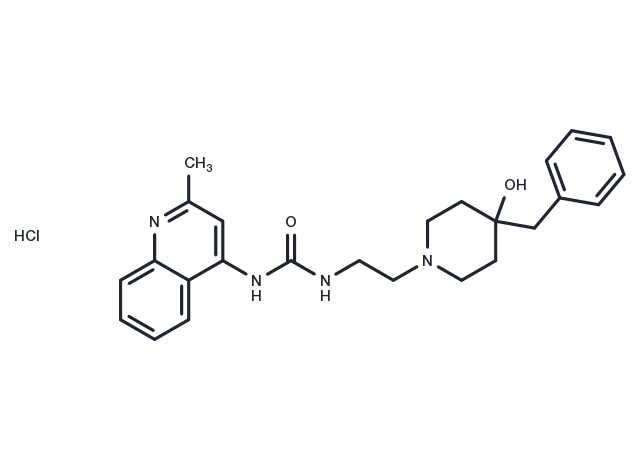Powder: -20°C for 3 years | In solvent: -80°C for 1 year


Palosuran hydrochloride 540769-28-6(free base)(ACT-058362 hydrochloride) is a new potent and specific antagonist of the human UT receptor with an IC50 of 3.6±0.2 nM.

| Pack Size | Availability | Price/USD | Quantity |
|---|---|---|---|
| 1 mg | Inquiry | $ 59.00 | |
| 2 mg | Inquiry | $ 106.00 | |
| 5 mg | Inquiry | $ 191.00 | |
| 10 mg | Inquiry | $ 297.00 | |
| 25 mg | Inquiry | $ 483.00 | |
| 50 mg | Inquiry | $ 691.00 | |
| 1 mL * 10 mM (in DMSO) | Inquiry | $ 191.00 |

| Description | Palosuran hydrochloride 540769-28-6(free base)(ACT-058362 hydrochloride) is a new potent and specific antagonist of the human UT receptor with an IC50 of 3.6±0.2 nM. |
| Targets&IC50 | GPR14:3.6 nM |
| In vitro | Palosuran inhibited 125I-U-II binding to human UT receptors in membrane preparations from CHO cells carrying the human UT receptors almost as potently as cold U-II, with an IC50 of 3.6 ± 0.2 nM. On cells, the inhibitory binding potency of palosuran against human UT receptor was lower than on membranes (IC50 = 46.2 ± 13 nM on TE 671 cells and 86 ± 30 nM on recombinant CHO cells). Compared with the human UT receptor, the binding inhibitory potency of palosuran against the rat UT receptor was lower in membrane preparation (400-fold), as well as in cells (>120-fold) [1]. |
| In vivo | Long-term treatment of streptozotocin-induced diabetic rats with palosuran improved survival, increased insulin, and slowed the increase in glycemia, glycosylated hemoglobin, and serum lipids. Furthermore, palosuran increased renal blood flow and delayed the development of proteinuria and renal damage [2]. Palosuran was rapidly absorbed with maximum plasma concentrations at 1 hour after drug administration. The accumulation factor was 1.7 (geometric mean) (95% confidence interval, 1.3 to 2.1).Palosuran was well tolerated [3]. In mesenteric vessels, palosuran treatment up-regulated expression of RhoA and Rho-kinase, increased Rho-kinase-activity, and diminished nitric oxide (NO)/cyclic guanosine 3',5'-monophosphate (cGMP) signaling. Moreover, palosuran increased renal blood flow, sodium, and water excretion in BDL rats [4]. |
| Synonyms | ACT-058362 hydrochloride |
| Molecular Weight | 454.99 |
| Formula | C25H31ClN4O2 |
| CAS No. | T4689 |
Powder: -20°C for 3 years | In solvent: -80°C for 1 year
DMSO: >30 mg/mL
You can also refer to dose conversion for different animals. More
bottom
Please see Inhibitor Handling Instructions for more frequently ask questions. Topics include: how to prepare stock solutions, how to store products, and cautions on cell-based assays & animal experiments, etc.
Palosuran hydrochloride 540769-28-6(free base) T4689 Endocrinology/Hormones GPCR/G Protein GPR Palosuran hydrochloride 540769-28-6(free base) ACT058362 Hydrochloride ACT-058362 Hydrochloride Palosuran hydrochloride 540769286(free base) ACT-058362 hydrochloride Palosuran hydrochloride 540769 28 6(free base) ACT 058362 Hydrochloride inhibitor inhibit
